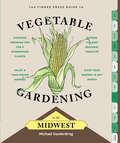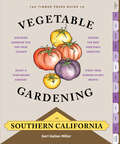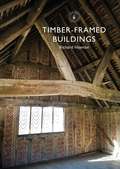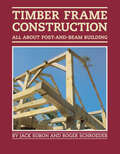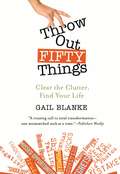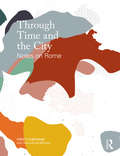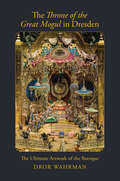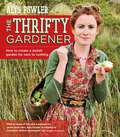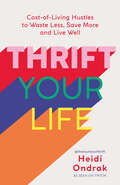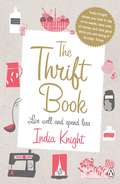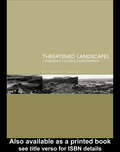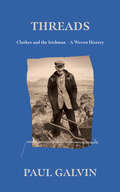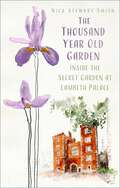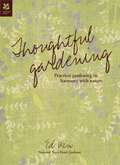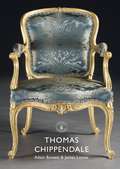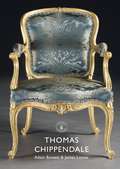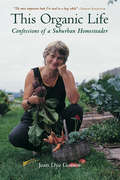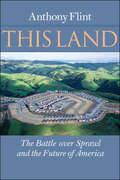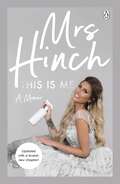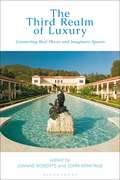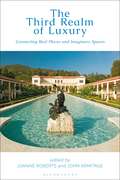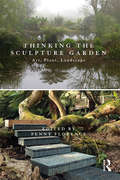- Table View
- List View
The Timber Press Guide to Vegetable Gardening in the Midwest (Regional Vegetable Gardening Series)
by Michael VanderBrugThis Timber Press Guide features an A–Z section that profiles the 50 vegetables, fruits, and herbs that grow best in the Midwest and provides basic care and maintenance for each.
The Timber Press Guide to Vegetable Gardening in Southern California (Regional Vegetable Gardening Series)
by Geri Galian MillerThis Timber Press Guide features an A–Z section that profiles the 50 vegetables, fruits, and herbs that grow best in Southern California and provides basic care and maintenance for each.
Timber-framed Buildings (Shire Library #879)
by Richard HaymanTimber-framed buildings are a distinctive and treasured part of Britain's heritage. The oldest of them are medieval but their numbers peaked in the sixteenth and seventeenth centuries, with a revival again in the nineteenth. The majority of timber-framed buildings are houses, but timber was used in all kinds of other buildings, including shops, inns, churches, town halls and farm buildings. This book outlines the history of timber-framed buildings, including their construction techniques, regional variations in style, and their social status. It also shows how the buildings have been treated in subsequent centuries and guides the reader in identifying timber-framing that is concealed behind later work. Illustrated with colour photographs, it is the ideal primer for anyone interested in timber-framed buildings who wants to explore them further.
Timber-framed Buildings (Shire Library)
by Richard HaymanTimber-framed buildings are a distinctive and treasured part of Britain's heritage, with such noteworthy examples as Little Moreton Hall, Anne Hathaway's Cottage and Lavenham Guildhall. The oldest are medieval but their numbers peaked in the sixteenth and seventeenth centuries, with a revival in the nineteenth. The majority of timber-framed buildings are houses, but wood was used in all kinds of other buildings, including shops, inns, churches, town halls and farm buildings.In this beautifully illustrated book, Richard Hayman outlines the history of timber-framed designs, and considers the techniques used in their construction, the regional variations in style that can be found, and how these buildings displayed social status. He also guides the reader in identifying structures now concealed behind later work and explores how these buildings have been treated in subsequent centuries.
Timber Frame Construction: All About Post-and-Beam Building
by Jack A. Sobon Roger SchroederDiscover the satisfaction of making your own durable, economical, and environmentally friendly timber frame structures. Covering all aspects of timber frame construction, this practical guide is filled with easy-to-understand instructions, clear illustrations, and helpful photographs. With expert advice on selecting appropriate timber, necessary tools, safety considerations, joinery techniques, assembly, and raising, Jack Sobon and Roger Schroeder encourage beginners by offering complete plans for a small toolshed. Turn your dream of a timber frame house into a reality.
Throw Out Fifty Things: Clear the Clutter, Find Your Life
by Gail Blanke"A perfect guide to getting the non-essentials out of the way, so that simple joys can make their way into our lives." -- Marianne Williamson, author of A Return to Love "If you want to grow, you gotta let go," is the mantra that bestselling author, columnist, and life coach Gail Blanke lives by. That means eliminating all the clutter - physical and emotional - that holds you back, weighs you down, or just makes you feel bad about yourself. In Throw Out Fifty Things she takes us through each room of the house - from the attic to the garage - and even to the far reaches of our minds. Through poignant and humorous stories, she inspires us to get rid of the "life plaque" we've allowed to build-up there.That junk drawer (you know that drawer) in the kitchen? Empty it! Those old regrets? Throw 'em out! That make-up from your "old" look? Toss it! That relationship that depresses you? Dump it! Once you've hit fifty (you'll be surprised how easy it is to get there) and once you've thrown out that too-tight belt and too-small view of yourself, you'll be ready to step out into the clearing and into the next, and greatest, segment of your life.
Through Time and the City: Notes on Rome
by Kristi Cheramie Antonella De MichelisThrough Time and the City: Notes on Rome offers a new approach to exploring cities. Using Rome as a guide, the book follows familiar sites, geographies, and characters in search of their role within a larger narrative that includes the environmental processes required to generate enough space and material for the city, the emergent ecologies to which its buildings play host, and the social patterns its various structures help to organize. Through Time and the City argues that Rome is made and unmade by an endlessly evolving chorus that has, for better or worse, gained geological legitimacy; that the city absorbs and emits countless artifacts in its search for collective identity; that the city is a platform for the constant staging of negotiations between agents (humans, buildings, plants, animals, pathogens, goods, waste, water) that drive and are driven by the entanglements of climate and culture. This book provides textual and visual frameworks for identifying the material traces, emergent patterns, or speculated futures that expose a city as inseparable from its capacity to change.
Through Time and the City: Notes on Rome
by Kristi Cheramie Antonella De MichelisThrough Time and the City: Notes on Rome offers a new approach to exploring cities. Using Rome as a guide, the book follows familiar sites, geographies, and characters in search of their role within a larger narrative that includes the environmental processes required to generate enough space and material for the city, the emergent ecologies to which its buildings play host, and the social patterns its various structures help to organize. Through Time and the City argues that Rome is made and unmade by an endlessly evolving chorus that has, for better or worse, gained geological legitimacy; that the city absorbs and emits countless artifacts in its search for collective identity; that the city is a platform for the constant staging of negotiations between agents (humans, buildings, plants, animals, pathogens, goods, waste, water) that drive and are driven by the entanglements of climate and culture. This book provides textual and visual frameworks for identifying the material traces, emergent patterns, or speculated futures that expose a city as inseparable from its capacity to change.
The Throne of the Great Mogul in Dresden: The Ultimate Artwork of the Baroque
by Dror WahrmanA masterful deciphering of an extraordinary art object, illuminating some of the biggest questions of the eighteenth century The Throne of the Great Mogul (1701–8) is a unique work of European decorative art: an intricate miniature of the court of the Mughal emperor Aurangzeb depicted during the emperor’s birthday celebrations. It was created by the jeweler Johann Melchior Dinglinger in Dresden and purchased by the Saxon prince Augustus the Strong for an enormous sum. Constructed like a theatrical set made of gold, silver, thousands of gemstones, and amazing enamel work, it consists of 164 pieces that together tell a detailed story. Why did Dinglinger invest so much time and effort in making this piece? Why did Augustus, in the midst of a political and financial crisis, purchase it? And why did the jeweler secrete in it messages wholly unrelated to the prince or to the Great Mogul? In answering these questions, Dror Wahrman, while shifting scales from microhistory to global history, opens a window onto major historical themes of the period: the nature of European absolutism, the princely politics of the Holy Roman Empire, the changing meaning of art in the West, the surprising emergence of a cross-continental lexicon of rulership shared across the Eastern Hemisphere, and the enactment in jewels and gold of quirky contemporary theories about the global history of religion.
The Thrifty Gardener: How To Create A Stylish Garden For Next To Nothing
by Alys FowlerForget makeover culture and all your gardening preconceptions, this is a witty, wise and practical take on to how to create a garden that suits you. The Thrifty Gardener is about creating the garden of your dreams, regardless of resources or limited space. It will eliminate the intimidation factor and reveal the ins-and-outs of soil, seeds, sowing and growing. At the heart of this book is a DIY ethic that says you don't always have to buy what you need, you can make it, take it or swap it with friends. From making window boxes out of wine cases to creating your own stylish compost bin, from bulking up perennials to finding plants for free, this book is packed with offbeat projects for a new generation of gardeners.
Thrift Your Life: Cost-of-Living Hustles to Waste Less, Save More and Live Well
by Heidi OndrakThe Queen of Thrift.' The Sun 'Super Saver Mum shares simple tips.' Daily MailFull of hacks and hustles to navigate those sudden changes in fortune that none of us could have predicted. This is a no-nonsense guide on how to change your habits to weather the storm, written by TikTok's queen of budgeting, Heidi Ondrak, aka The Duchess of Thrift.Life rarely follows a linear path, sh*t happens that you could have controlled better, and then stuff happens that you have absolutely no control over whatsoever, like the current cost-of-living crisis. Full of practical hacks to adapt to life's financial ups and downs and guaranteed to help you save every month, Heidi will show you how to nurture resilience alongside some of those cheeky life hacks that no one teaches in schools. Think of it as a modern-day take on Mrs Beeton's Book of Household Management, with extra sass.Hacks range from the well-versed and practical to the downright outrageous – pick and choose, do what suits you. Heidi will help you build a toolkit to get you through the crisis and feel prepared and in control for more energy increases, interest rate rises and eye-watering inflation, while doing it with a fighting spirit and sunny demeanor. You'll learn how to change your mindset, get the family on board, carry out budget health checks, shop smarter, look a million dollars for pennies, have great days out, enjoy Xmas and be able to get around... All on a shoestring!
The Thrift Book: Live Well and Spend Less
by India KnightThe Thrift Book is a guide to how to live well while spending less by bestselling writer India Knight.Feeling poor because of the credit crunch? Feeling guilty because of global warming? Feeling like you'd like to tighten your belt, but aren't ready to embrace DIY macramé handbags? No need to panic. Put down the economy mince and buy this book instead - it's a blueprint for living beautifully, while saving money and easing your conscience. India Knight will show you:- How to make wonderful dinners with every little money- How to dress on a budget and still look fabulous- How to make friends and start sharing with your neighbours- How to holiday imaginatively - with barely a carbon footprintTry it - you have nothing to lose but your overdraft.'A blueprint for living well, however broke you are, with thrifty tips on looking fab, cooking, pampering and partying' Cosmopolitan'The Thrift Book might be the only sure-fire investment out there' Harper's Bazaar'A triumphant treat and a useful and sensible manual' IndependentIndia Knight is the author of four novels: My Life on a Plate, Don't You Want Me, Comfort and Joy and Mutton. Her non-fiction books include The Shops, the bestselling diet book Neris and India's Idiot-Proof Diet, the accompanying bestselling cookbook Neris and India's Idiot-Proof Diet Cookbook and The Thrift Book. India is a columnist for the Sunday Times and lives in London with her three children.Follow India on Twitter @indiaknight or on her blog at http://indiaknight.tumblr.com.
Threatened Landscapes: Conserving Cultural Environments
by Bryn Green Willem VosFew, if any, environments are free of human intervention. Often this generates ecosystems which are rich in biodiversity, historical interest, recreational opportunity and scenic beauty just as worthy of conservation as the more natural ecosystems on which protection programmes have been almost exclusively focussed.These 'cultural landscapes', ranging from the farm and forest lands of Europe and Eastern North America, through to the pasture lands and savannas of the Middle East and Africa to the paddylands of the Pacific Rim, are usually the product of relatively low-level, sustainable exploitation of the environment over long periods of time. Many have survived for centuries, if not millennia, but now urban expansion, depopulation of rural areas and, most damagingly, the intensification of agricultural and sylvicultural practices, are everywhere leading to a loss of their cherished biodiversity and amenity. Whilst past changes have mostly added to the valued characteristics of these landscapes, modern farming and forestry are creating sterile monocultures on the better land whilst marginal lands are being abandoned.This book documents these changes, illustrates them through detailed case studies of a representative selection of threatened landscapes, analyses their underlying causes and explores ways by which they can continue to be maintained, or new landscapes created which maintain their desired characteristics.
Threatened Landscapes: Conserving Cultural Environments
by Bryn Green Willem VosFew, if any, environments are free of human intervention. Often this generates ecosystems which are rich in biodiversity, historical interest, recreational opportunity and scenic beauty just as worthy of conservation as the more natural ecosystems on which protection programmes have been almost exclusively focussed.These 'cultural landscapes', ranging from the farm and forest lands of Europe and Eastern North America, through to the pasture lands and savannas of the Middle East and Africa to the paddylands of the Pacific Rim, are usually the product of relatively low-level, sustainable exploitation of the environment over long periods of time. Many have survived for centuries, if not millennia, but now urban expansion, depopulation of rural areas and, most damagingly, the intensification of agricultural and sylvicultural practices, are everywhere leading to a loss of their cherished biodiversity and amenity. Whilst past changes have mostly added to the valued characteristics of these landscapes, modern farming and forestry are creating sterile monocultures on the better land whilst marginal lands are being abandoned.This book documents these changes, illustrates them through detailed case studies of a representative selection of threatened landscapes, analyses their underlying causes and explores ways by which they can continue to be maintained, or new landscapes created which maintain their desired characteristics.
Threads: Clothes and the Irishman - A Woven History
by Paul GalvinTaking the clothes they wore as a starting point, Paul Galvin skilfully weaves together a collection of stories of Irishmen who defined the culture and mood of their time.In Push, he tells the story of the legendary Walker Brothers – cyclists and soldiers who pedalled through a storm for Ireland at the 1912 Stockholm Games and subsequently served as rebel bike couriers during the 1916 Rising. In Born Mad, discover another side to Samuel Beckett – sartor and prolific sportsman who had knockout power as a champion school’s boxer. In Boland, we learn about Harry Boland’s background as a trained tailor, and in Jack, we encounter Jack B. Yeats at the 1924 Olympic Games in Paris.These are just some of men who have inspired Paul’s own fashion collections and whom he writes about here in a fascinating collection that shines a light on how history is woven into the clothes Irishmen wear.
The Thousand Year Old Garden: Inside the Secret Garden at Lambeth Palace
by Nick Stewart Smith“A fascinating and intimate portrait of a garden over time … Reading is like being given a rusty key to a beautiful secret garden.” - Ben Dark, Author of The GroveExplore the magical green world of Lambeth Palace Garden, a hidden jewel of London for more than 1,000 years. In this book, Head Gardener Nick Stewart Smith takes the reader on a series of rambles through the changing seasons, introducing some extraordinary trees and plants along the way. Revealing some of the untold stories of the ten-acre secret garden, this is a unique insight into a special place. Nick explains how nature is at the heart of everything here, the gardening approach allowing the green world inside the high stone walls to be a haven for many kinds of wildlife, all flourishing right in the midst of one of the world’s busiest cities.
Thoughtful Gardening: Practical Gardening In Harmony With Nature
by Ed IkinAn essential book for all gardeners who want to give a bit more thought into the way they garden Advice on gardening in harmony with nature From gardening during drought conditions to the best friendly fungi Plus how to make the perfect compost
Thomas Chippendale (Shire Library)
by Adam Bowett James LomaxFor at least 150 years, Thomas Chippendale has been synonymous with beautifully made eighteenth-century furniture in a variety of styles – Rococo, Chinese, Gothic and Neoclassical. Born in Otley, Yorkshire, in 1718, Chippendale rose to fame because of his revolutionary design book, The Gentleman and Cabinet Maker's Director, published in 1754. That same year he set up his famous workshops in St Martin's Lane, creating some of the most magnificent furniture ever made in Britain. This beautifully illustrated history focuses on Britain's most famous furniture maker and designer, including the worldwide phenomenon 'Chippendale style' that became popular in Europe, North America and Asia after his death in 1779. Today, his influence lives on with the ongoing production of 'Chippendale' furniture, while the eighteenth-century originals are selling for millions at auction.
Thomas Chippendale (Shire Library)
by Adam Bowett James LomaxFor at least 150 years, Thomas Chippendale has been synonymous with beautifully made eighteenth-century furniture in a variety of styles – Rococo, Chinese, Gothic and Neoclassical. Born in Otley, Yorkshire, in 1718, Chippendale rose to fame because of his revolutionary design book, The Gentleman and Cabinet Maker's Director, published in 1754. That same year he set up his famous workshops in St Martin's Lane, creating some of the most magnificent furniture ever made in Britain. This beautifully illustrated history focuses on Britain's most famous furniture maker and designer, including the worldwide phenomenon 'Chippendale style' that became popular in Europe, North America and Asia after his death in 1779. Today, his influence lives on with the ongoing production of 'Chippendale' furniture, while the eighteenth-century originals are selling for millions at auction.
This Organic Life: Confessions of a Suburban Homesteader (Polyface Titles Ser.)
by Joan Dye GussowJoan Dye Gussow is an extraordinarily ordinary woman. She lives in a home not unlike the average home in a neighborhood that is, more or less, typically suburban. What sets her apart from the rest of us is that she thinks more deeply--and in more eloquent detail--about food. In sharing her ponderings, she sets a delightful example for those of us who seek the healthiest, most pleasurable lifestyle within an environment determined to propel us in the opposite direction. Joan is a suburbanite with a green thumb, with a feisty, defiant spirit and a relentlessly positive outlook. At the heart of This Organic Life is the premise that locally grown food eaten in season makes sense economically, ecologically, and gastronomically. Transporting produce to New York from California--not to mention Central and South America, Australia, or Europe--consumes more energy in transit than it yields in calories. (It costs 435 fossil fuel calories to fly a 5-calorie strawberry from California to New York.) Add in the deleterious effects of agribusiness, such as the endless cycle of pesticide, herbicide, and chemical fertilizers; the loss of topsoil from erosion of over-tilled croplands; depleted aquifers and soil salinization from over-irrigation; and the arguments in favor of "this organic life" become overwhelmingly convincing. Joan's story is funny and fiery as she points out the absurdities we have unthinkingly come to accept. You won't find an electric can opener in this woman's house. In fact, you probably won't find many cans, as Joan has discovered ways to nourish herself, literally and spiritually, from her own backyard. If you are looking for a tale of courage and independence in a setting that is entirely familiar, read her story.
This Land: The Battle over Sprawl and the Future of America
by Anthony FlintDespite a modest revival in city living, Americans are spreading out more than ever—into "exurbs" and "boomburbs" miles from anywhere, in big houses in big subdivisions. We cling to the notion of safer neighborhoods and better schools, but what we get, argues Anthony Flint, is long commutes, crushing gas prices and higher taxes—and a landscape of strip malls and office parks badly in need of a makeover.This Land tells the untold story of development in America—how the landscape is shaped by a furious clash of political, economic and cultural forces. It is the story of burgeoning anti-sprawl movement, a 1960s-style revolution of New Urbanism, smart growth, and green building. And it is the story of landowners fighting back on the basis of property rights, with free-market libertarians, homebuilders, road pavers, financial institutions, and even the lawn-care industry right alongside them.The subdivisions and extra-wide roadways are encroaching into the wetlands of Florida, ranchlands in Texas, and the desert outside Phoenix and Las Vegas. But with up to 120 million more people in the country by 2050, will the spread-out pattern cave in on itself? Could Americans embrace a new approach to development if it made sense for them?A veteran journalist who covered planning, development, and housing for the Boston Globe for sixteen years and a visiting scholar in 2005 at the Harvard Design School, Flint reveals some surprising truths about the future and how we live in This Land.
This Is Me: The Sunday Times No 1 Bestseller
by Mrs HinchDiscover the true story of the real Sophie Hinchliffe for the very first time in her extraordinarily candid memoirTHE SUNDAY TIMES NO. 1 BESTSELLER'Gut-wrenchingly honest' Mail on Sunday________Well guys, here we are! What an absolute whirlwind of a journey this has been so far.So much has happened in the last couple of life-changing years and I'm so excited to share it with you all: my Hinchers. You have been right by my side for every step of the way and I honestly couldn't have done it without the amazing love and support from this incredible family we've built together.It's often felt like a fairy tale but it hasn't always been easy, and I'm going to let you in on the highs and the lows as well as my biggest fears and my darkest challenges. Because this book right here, is me.This is me: Soph - the wife, the mother and the person behind Mrs Hinch.So let's do this! Put your Hinch Lists to one side, get comfy and join me on the sofa with a cuppa. Welcome to my world.This is my story.________'The sensation' Sun'We're mad about Mrs Hinch' Vogue'My new cleaning goddess' Daily Telegraph'Doing for household chores what Marie Kondo did for tidying' Daily Mirror'Mrs Hinch offers a reassuring structure for the day, a vision of domestic order' Guardian
The Third Realm of Luxury: Connecting Real Places and Imaginary Spaces
by Joanne Roberts John ArmitageIn a world that is obsessed with luxury, critical luxury studies is a rapidly emerging field. This is the first book to explore the interplay between the real and imaginary realms of luxury, considering the most significant developments in the theories and practices of luxurious places and spaces over the last fifty years.Providing a critical approach to contemporary interpretations of luxury, the book interrogates the distinction between real places and imaginary spaces. Bringing together an interdisciplinary group of leading scholars, it features a range of case studies which take the reader from the Rolls-Royce Ghost Black Badge to expressions of sensuality in the 1970s domestic interior, and global conceptions of fine wine and art.The Third Realm of Luxury considers the interplay between luxury and space in both the past and the present, examining the abstract conception of excess and exoticism, as well as the real locations of the home, hotel, apartment, and palace. Full of original research, it is a key contribution to the study of consumption, design, fashion, and architecture.
The Third Realm of Luxury: Connecting Real Places and Imaginary Spaces
In a world that is obsessed with luxury, critical luxury studies is a rapidly emerging field. This is the first book to explore the interplay between the real and imaginary realms of luxury, considering the most significant developments in the theories and practices of luxurious places and spaces over the last fifty years.Providing a critical approach to contemporary interpretations of luxury, the book interrogates the distinction between real places and imaginary spaces. Bringing together an interdisciplinary group of leading scholars, it features a range of case studies which take the reader from the Rolls-Royce Ghost Black Badge to expressions of sensuality in the 1970s domestic interior, and global conceptions of fine wine and art.The Third Realm of Luxury considers the interplay between luxury and space in both the past and the present, examining the abstract conception of excess and exoticism, as well as the real locations of the home, hotel, apartment, and palace. Full of original research, it is a key contribution to the study of consumption, design, fashion, and architecture.
Thinking the Sculpture Garden: Art, Plant, Landscape
by Penny FlorenceThis innovative book poses two, deceptively simple, questions: what is a sculpture garden, and what happens when you give equal weight to the main elements of landscape, planting and artwork? Its wide-ranging frame of reference, including the USA, Europe and Japan, is brought into focus through Tremenheere Sculpture Garden, Cornwall, with which the book begins and ends. Effectively less than 15 years old, and largely the work of one man, Tremenheere affords an opportunity to examine as work-in-progress the creation of a new kind of sculpture garden. Including a historical overview, the book traverses multiple ways of seeing and experiencing sculpture gardens, culminating in an exploration of their relevance as 'cultural ecology' in the context of globalisation, urbanisation and climate change. The thinking here is non-dualist and broadly aligned with New Materialisms and Material Feminisms to explore our place as humans in the non-human world on which we depend. Eminent contributors, including John Dixon Hunt, George Descombes, Bernard Lassus and David Leatherbarrow, approach these issues through practices and theories of landscape architecture; garden and art making; history and writing; and philosophy. Richly illustrated with over 100 images, including a colour plate section, the book will primarily appeal to those engaged in professional or academic research, along with sculpture garden visitors, who will find new and surprising ways of experiencing plants and art in natural and urban settings.
